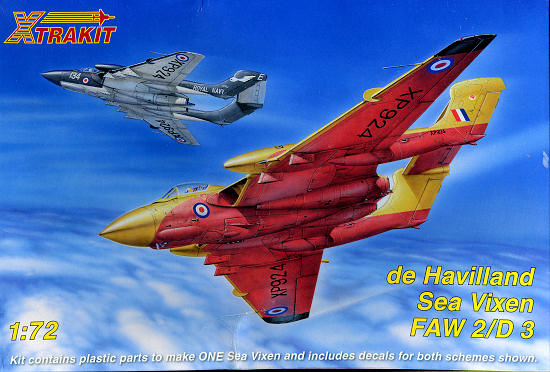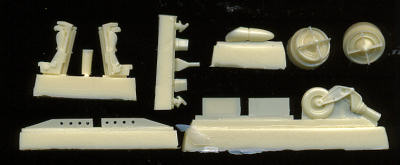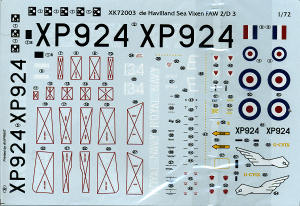
XtraKit 1/72 Sea Vixen FAW.2/D.3
| KIT: | XtraKit 1/72 Sea Vixen FAW.2/D.3 |
| KIT #: | XK72003 |
| PRICE: | £16.99 from www.hannants.co.uk |
| DECALS: | Two options |
| REVIEWER: | Scott Van Aken |
| NOTES: | New mold kit with resin parts and canop masks |

| HISTORY |
The de Havilland DH.110 Sea Vixen was a 1950s-1960s British two-seat jet fighter of the Fleet Air Arm (the air component of the Royal Navy). Developed from an earlier first generation jet fighter, the Sea Vixen was a capable carrier-based fleet defence fighter that served into the 1970s.
The Sea Vixen had a twin-boom tail, as used on thede Havilland Sea Vampire and de Havilland Sea Venom. The Sea Vixen became the first British aircraft to be solely armed with missiles, rockets and bombs. The Sea Vixen FAW.1 was armed with four de Havilland Firestreak air-to-air missiles, two Microcell unguided 2-inch (51 mm) rocket packs and had a capacity for four 500 lb (230 kg) bombs or two 1,000 lb bombs. It was powered by two 50.0 kN (11,230 lbf) thrust Rolls-Royce Avon 208 turbojet engines; had a speed of 690 mph (1,110 km/h) and a range of 600 miles (1,000 km).
The original DH.110 design (as offered to the RAF)did have the fitting of cannons in its prospectus. Experiments with ADEN cannons were carried out and it was found that their firing caused failure of the mountings due to the force of the recoil. The solution was to put a baulk (reinforcing piece) of timber in place to absorb the recoil force. Thus the Vixen was also the last British fighter to use wood in its construction. The cannons were soon removed and an all-missile armament was developed.
The pilot's canopy is offset to the left hand side. The other crew member (the navigator) was housed to the right completely within the fuselage, gaining access through a flush-fitting top hatch into his space (known in the service as the "coal hole") which had a small window.
The Sea Vixen FAW.2 was the successor to the FAW.1 and included many improvements. As well as Firestreak missiles, it could carry the Red Top AAM, four SNEB rocket pods and the air-to-ground Bullpup missile. An enlarged tail boom allowed for additional fuel tanks in the "pinion" extensions above and before the wing leading edge, and there was an improved escape system along with additional room for more electronic counter-measures equipment. However, the changes in aerodynamics meant that the 1,000 lb bomb was no longer able to be carried. Visually the FAW.1 and FAW.2 may be distinguished by the tail booms which extend forward over the leading edge of the wing on the FAW.2.
The Sea Vixen FAW.2 first flew in 1962 and entered service with front-line squadrons in 1964, with 29 being built and a further 67FAW.1s being upgraded toFAW.2 standard. TheFAW.1 began phasing out in 1966.
In 1972, the career of the Sea Vixen FAW.2 came to an end. It was planned to replace the Sea Vixen with the McDonnell Douglas Phantom, with both Ark Royal andEagle to be refitted to take the new aircraft. In the event, due to defence cuts, following the decommissioning of HMS Eagle only Ark Royal was converted to take the new aircraft.
A small number of Sea Vixen subsequently saw service in the less glamorous roles of drone, being redesignated Sea Vixen D.3. The D.3 variant is the only DH.110 design that was truly capable of supersonic speeds in level flight, thanks largely to uprated engine specifications and removal of many non-essential and military fitments. They were never used in the drone role and only a few were actually converted to the D 3 standard. The last remaining airworthy Sea Vixen was one of these. Other Sea Vixens became target tugs and were redesignated as TT.2.
| THE KIT |
 There has been a long time need for a new mold Sea Vixen and thanks to XtraKit, we now have one. Molded by MPM in the Czech Republic, this new kit has the sort of detailing that was only a dream with the older Frog kit. Starting with the cockpit, there is actual detail in here with nicely done consoles, instrument panels and seats. The seats are a bit on the small size an adjustment neede in order to fit into the cramped spaces of the cockpit. As little will actually be visible once together, a modeler could go with proper sized aftermarket seats and leave out some of the detailing to get them to fit. Most will use the nice ones in the kit.
There has been a long time need for a new mold Sea Vixen and thanks to XtraKit, we now have one. Molded by MPM in the Czech Republic, this new kit has the sort of detailing that was only a dream with the older Frog kit. Starting with the cockpit, there is actual detail in here with nicely done consoles, instrument panels and seats. The seats are a bit on the small size an adjustment neede in order to fit into the cramped spaces of the cockpit. As little will actually be visible once together, a modeler could go with proper sized aftermarket seats and leave out some of the detailing to get them to fit. Most will use the nice ones in the kit.
 These seats and some other smaller parts are made of resin. That includes the engine exhaust compressors, nose wheel/gear assembly, fences under the fuselage, nose gear doors, radar hood, refueling probe stub and a few other smaller bits. These parts are superbly formed and devoid of any glitches.
These seats and some other smaller parts are made of resin. That includes the engine exhaust compressors, nose wheel/gear assembly, fences under the fuselage, nose gear doors, radar hood, refueling probe stub and a few other smaller bits. These parts are superbly formed and devoid of any glitches.
Though the wings are not designed to be folded, the outer sections are separate and there are bulkhead blanks that go in the open ends to help get the parts together. This would also make it easier for those doing aftermarket wingfold parts to design them. The kit has full intake trunking to a compressor face section and has separate and full wheel wells. The separate nose cone leaves room for weights. Hannants has told me that all the nose cones have a dimple in them, something easy enough to fill. There are six under wing pylons but no weapons, only a pair of fuel tanks for the outer pylons. A separate windscreen and canopy, both crystal clear, are included and the kit offers the large boom mounted fuel tanks as separate assemblies, allowing the FAW.1 variant to be done if one so desires (though none of the decal options are for this version).
 Instructions are well done and provide nicely done drawings in 19 construction steps. Colors are, of course, for Xtracolor and Xtracrylic paints, but generic names are provided for those who cannot get these paints. Decals are provided for two aircraft, both shown on the box art. One is an 899 squadron FAW.2 in extra dark sea grey over white, while the other is the last flying Sea Vixen, a D.3 drone in yellow and red. XtraKit has included a set of masks for the clear bits and for the curved areas of the D.3 version (not shown as it would look like a yellow square). There are no instructions regarding these masks nor are they mentioned in the instruction sheet or painting/decal guide. Decals are superbly printed and provide a full data/stencil suite as well.
Instructions are well done and provide nicely done drawings in 19 construction steps. Colors are, of course, for Xtracolor and Xtracrylic paints, but generic names are provided for those who cannot get these paints. Decals are provided for two aircraft, both shown on the box art. One is an 899 squadron FAW.2 in extra dark sea grey over white, while the other is the last flying Sea Vixen, a D.3 drone in yellow and red. XtraKit has included a set of masks for the clear bits and for the curved areas of the D.3 version (not shown as it would look like a yellow square). There are no instructions regarding these masks nor are they mentioned in the instruction sheet or painting/decal guide. Decals are superbly printed and provide a full data/stencil suite as well.
I cannot close without thanking XtraKit for putting this in a real, two piece box. I am one of many who detest the end opening boxes as it provides no place to store the kit bits as one is working on the model.
| CONCLUSIONS |
So there you have it. A new mold Sea Vixen. I'm sure that this one will sell quite well and it doesn't hurt that XtraDecal has concurrently produced a new sheet with all the other unit markings on it. Hey, this means you can buy more than one!
| REFERENCES |
http://en.wikipedia.org July 2008 My thanks to the fine folks at www.hannants.co.uk for the preview kit. Get this kit and the new sheet from the link. If you would like your product reviewed fairly and fairly quickly , please contactme or see other details in the